|
|
|
|
|
Baffle pipes - and recent modifications
The construction is obvious, with the exception of the small holes drilled in each pipe to gently let the water flow into the top of the filter. Don't glue the pipes; they will be very difficult to clean if you do.
The construction is obvious, with the exception of the small holes drilled in each pipe to gently let the water flow into the top of the filter. Don't glue the pipes; they will be very difficult to clean if you do.
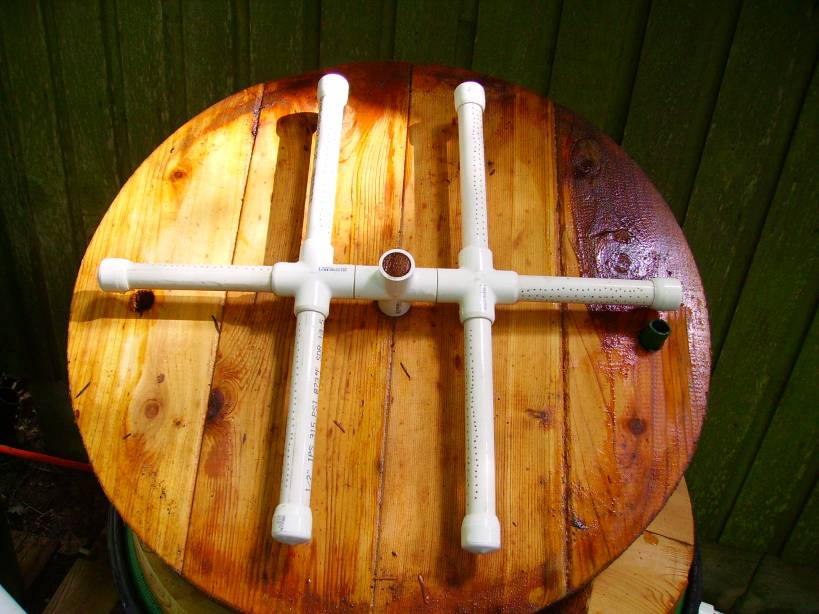 Baffle pipe modification note the beveling of the sharp edges 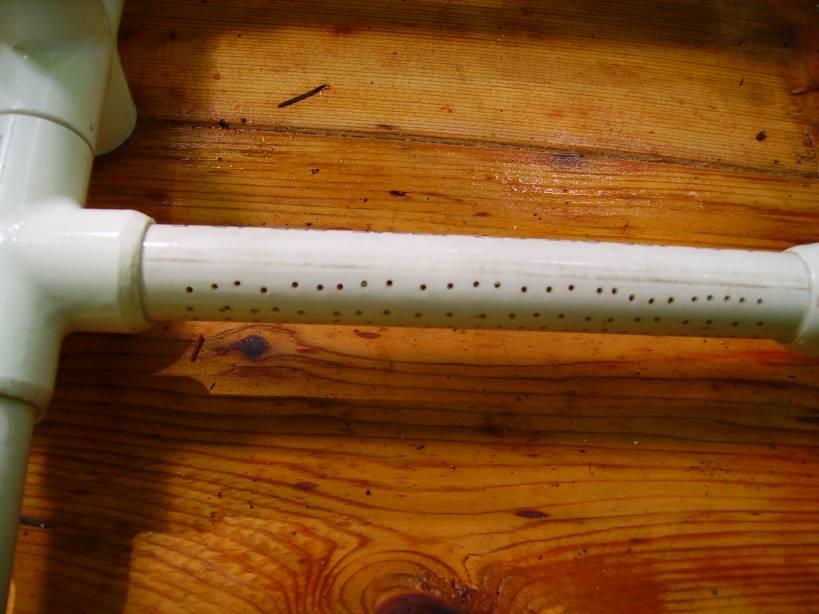 Baffle pipe modification note the beveling of the sharp edges and the 2 extra rows of holes drilled. |
|||
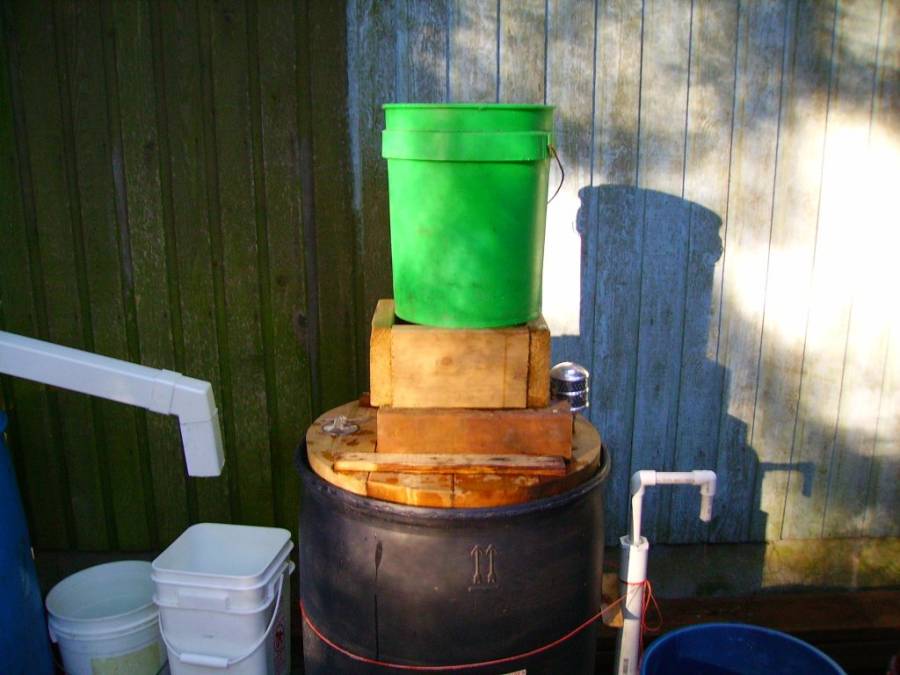 A 5 gallon bucket on top, in place of the 4 inch pvc, with a very small hole in the bottom will allow the filter to run for quite some time. I used the same drill as on the baffle pipes. A cloth on top keeps the small hole from getting plugged by small organic particles. This is made from things I had on hand. Most of the material is of very low cost. These buckets can be found for free without lids; however be sure you know what was in them originally - food grade containers are recommended. 2007-08-21: The sand used in the filter has been changed. Now the top layer of fine sand is graded quartz silica sand: .15 mm effective size. This will give better filtering and allow the biofilm to form more effectively; and this sand is very easy to wash - it runs clean in just a few minutes of washing. Don't let the silica thing scare you; just be very careful and don't breathe the dust - I would suggest wearing a protective mask while you clean the sand. Wet silica sand is harmless and is used in many water filters. A word here about sand:Be absolutely certain of what is in the sand you use. Know exactly where it comes from. There could be any kind of harmful substance in sand - asbestos (naturally occuring), petroleum distillates (from runoff), arsenic (naturally occuring) pesticides and/or herbicides (runoff from urban areas) the list goes on . . . . If you are not sure where to get "pure sand" check for nsa/ansi 61 or awwa b100 certification. 2007-09-01: The top layer of sand down to 2 inches of coarse sand above the gravel has been changed to 2 inches of fine sand with 25 inches of graded sand (effective size .15mm) on top of that. I have added the bucket on top so the water can flow through the filter for quite some time without constant monitoring. I suppose a 10 gallon bucket could also be used which would allow water to flow through the filter for much longer. It would only have to be filled once a day. This graded sand is an off-white color so it is easy to see when the bio-layer has formed. The sand on top will turn greenish brown - looks like pond-scum but actually it is a very good thing - it is nature's filtering system and it works. The most recent test demonstrates that fact - the filter removes enough of the bacteria in the roof runoff water such that none are found in the 100 ml samples. This modified version of the first design has a flow rate of 3 gallons per hour. This is a low flow but the water that comes out is clean. A more substantial flow could be produced by using coarser sand and / or having more water on top of the sand, but the water may not be as clean. Four of these at each corner of a house at a downspout would supply 12 gallons per hour during each rain event. This is quite sustainable technology. Most of the filter is made utilizing already existing products. This filter sand will be usefull for five or six years, at which time the sand may have to be replaced. The used sand will go into the vegetable garden, where it will be used, mixed together with compost, to grow food, and flowers. The rest of the filter, if kept out of direct sunlight, will be usefull for many years. We are now working on a slightly less sustainable, but much more convenient system. This set up uses a small 12 volt rv faucet pump (ideally powered by solar panels) to recirculate water from the filter that is stored in a 45 gallon storage tank. This water is fed back into the filter at several gallons per hour, therby maintaining a supply of oxygenated water to keep the biofilm alive. A faucet or outlet (which has not yet been installed) about 3/4 of the way down on the storage tank will allow water to be collected until the level goes to below the faucet; then water will be recirculated but not available until more water is added to the system. This will be particularly useful in the summer when temperature rises and less oxygen is available in the water, but more sunlight is available to power the pump. The question is: will there be enough organic matter in the circulated water to keep the proper population of microbes alive in the biofilm? Possibly. If occasional 5 gallon quantities of untreated water are added regularly, the filter should function properly. The water will be tested and I will post the results when they are available. Feb 28 2008: The most recent test strongly suggests the biofilm can be maintained in this way. 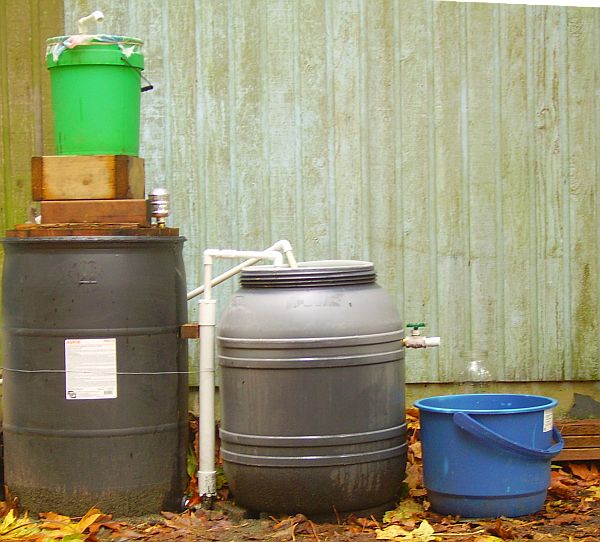 A 45 gallon storage tank added (smaller barrel on the right) stores the water that has gone through the filter. From there it is pumped back into the filter at 3.5 gallons per hour using a small dc powered pump. This keeps the oxygen supply available to the biofilm. There is an outlet in the storage barrel to catch the filtered re-circulated water for use. 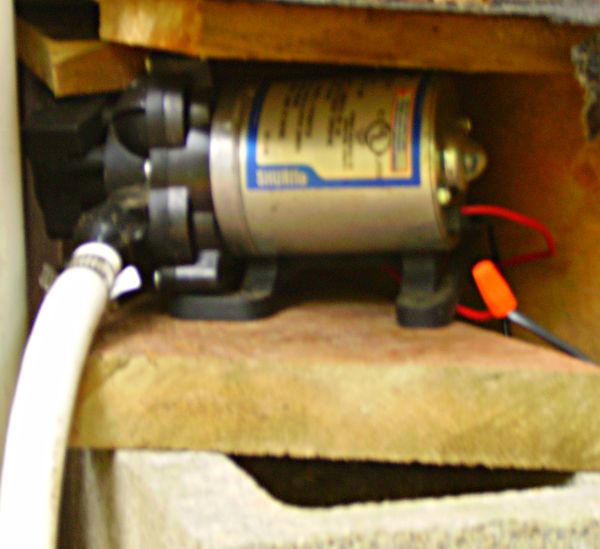 This is the pump that I have used to circulate the water. It is powered by a 12 volt deep-cycle marine battery, which can easily be kept charged up (ideally) by a solar panel, or a small battery charger. It can also be used to supply pressurized water to your house while also recirculating the water if you have a much larger storage tank - just use two valves on a tee - (one for the low flow and the other to your water supply) , since the water being pumped back into the filter is already cleaned. There are probably as many ways to do this as there are plumbers in your neighborhood. 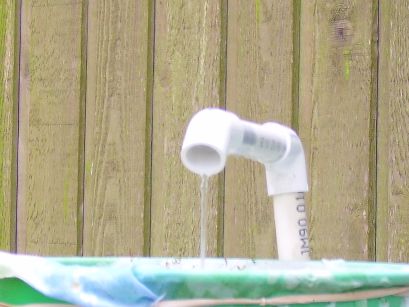 The picture above shows what a "3.5 gallons per hour" flow looks like. 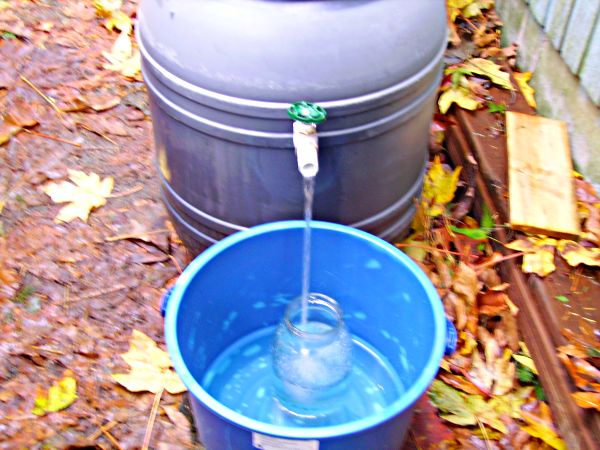 Outlet and filtered water flow from storage tank 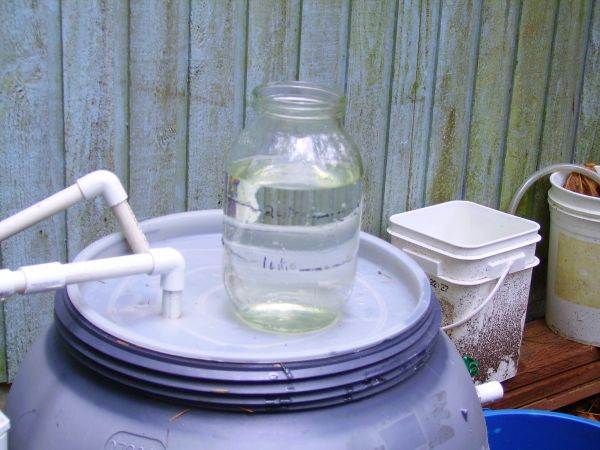 Clean water! These filters work. And they work well. The water from this filter is better than our well water. It would not surprise me if this water was better than most "tap" water in large cities or for that matter, bottled water. This system produces no left over plastic bottles, and for the price you would pay for four or five cases of "top quality" bottled water, you can probably build this entire filter. If you buy bottled water year round you could easly pay for the battery, pump, storage barrels and filter for less than it would cost you for the bottled water. Then all your water is free. But you don't even need the pump or battery. If you are living in one of the many areas in the U.S. that are now experiencing 50 or 100 year droughts you may want to consider this seriously . . . build it and have it ready for the first rain, and you will have all the water you need to water your flowers or wash your car, or irrigate your vegetable garden . . . what ever - it's your water, and your choice of what to do with it, and your responsibility for the results. Just remember that the filter must be in operation for at least 4 weeks before the water from it is safe - and be sure to have the water tested before you ever use any of it and use a UV filter at the point of use. I cannot stress this enough, and furthermore I do not recommend drinking water from any filter I describe on any of my websites - the operation of a small slow sand water filter is TOTALLY the responsibilty of the owner / operator. The filters I have built work, your results may, and probably will, vary considerably. Also, any chemicals you have put on your roof will be in the water you collect. (A "first flush diverter" may help to minimize chemicals dissolved in water collected from a roof) Incidentally those chemicals will eventually end up in water anyway (in lesser concentration) because they flow off your roof into the ground and eventually back into a river or acquifer. In fact, any chemicals you have on your roof - moss killers, petro chemical distillates from shingles, lead residue from vent seals and dust from air pollution, get washed off your roof and into the ground where they build up and eventually run off into surface water - which in turn ends up in rivers, lakes, and streams, and will eventually find their way into your grandchildren's water supply. If you have a surface well you are probably already drinking these chemicals. Public water supply systems cost millions of dollars because they attempt to (and usually do) remove chemicals and bacteria from surface water (the source of public water) Maybe if we all were taking water from our roofs to drink we would think more about what we are putting into our water and on our roofs. An 1800 square foot roof will collect over 2200 gallons of water with 2 inches of rainfall. If you have 6 downspouts equally spaced that means each one will deliver over 300 gallons of water. This whole thing assumes you are smart enough to read all the links provided on this site and do a little reading on water quality so you understand the risks involved. You don't need a college degree to be smart enough to figure out how to be careful and how to operate one of these filters. The basic operation is simple. The biofilm that grows on the sand eats nasty bacteria and viruses and forms a membrane that only allows water to pass throught it. These filters (much larger of course) are used in Europe extensively for municiple water supplies. The problem is they don't support chemical companies because they don't require any chemicals to operate, and they cannot provide as much water as fast as it is needed for life in the fast lane U.S.A. style. . Go figure. back |
|
|

This work is licensed under a Creative Commons Attribution-ShareAlike 2.5 License. terms of use
